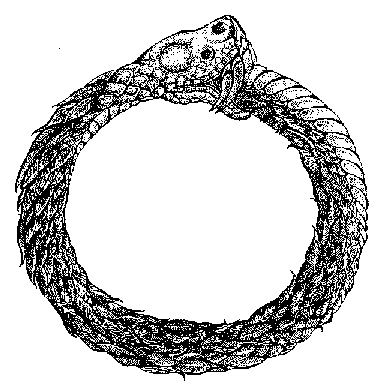|
Magic with Circles Not all references to the circle are benign. Dante Alighieri, in the Inferno, from his La Divina Commedia, described the circles of Hell. For two centuries, the dark side of the search for knowledge has been associated with Goethe’s Faust [26]. In one scene, a witch draws a circle to cast a spell: This is the way to take a witch in hand. The Witch: Now, gentlemen, what say you I shall do? Mephistopheles: A good glass of the well-known juice, Yet I must beg the oldest sort of you. A double strength do years produce. The Witch: With pleasure! Here I have a bottle From which I sometimes wet my throttle, Which has no more the slightest stink; I'll gladly give a little glass to you. [In a low tone.] And yet this man, if unprepared he drink, He can not live an hour, as you know too. Mephistopheles: He is a friend of mine whom it will profit well; I would bestow your kitchen's best on him. So draw your circle, speak your spell, Give him a cup full to the brim! [The Witch with curious gestures draws a circle and places marvelous things in it; meanwhile the glasses begin to ring, the cauldron to sound and make music. Lastly, she brings a large book and places the Apes in a circle so as to make them serve as reading-desk and hold the torch. She beckons Faust to come near her.] Faust [to Mephistopheles]: What is to come of all this? Say! These frantic gestures and this crazy stuff? This most insipid, fooling play, I've known and hated it enough. Mephistopheles: Nonsense! She only wants to joke us; I beg you, do not be so stern a man! Physician-like, she has to play some hocus-pocus So that the juice will do you all the good it can. [He obliges Faust to step into the circle.]
When the miller got home, his wife said, "Tell me, from whence
The miller's daughter was a beautiful, pious girl, and lived through
Just as did the ancient Greeks, the philosophers of the seventeenth century used the circle as an example of mathematical idealization, to distinguish between an idea and an actual item. Consider that, in 1690, Locke wrote the following [28].
Hence the reality of mathematical knowledge.... The mathematician
Although the mathematically pure circle doesn’t exist in the tangible world, it is present in aspects of many parts of life, as Walt Whitman wrote in Leaves of Grass [29]
Facing west from California's shores,
I, a child, very old, over waves, towards the house of maternity, the land of migrations, look afar, Look off the shores of my Western sea, the circle almost circled; For starting westward from Hindustan, from the vales of Kashmere, From Asia, from the north, from the God, the sage, and the hero, From the south, from the flowery peninsulas and the spice islands, Long having wander'd since, round the earth having wander'd,
Now I face home again, very pleas'd and joyous,
And why is it yet unfound?) To us, the poet here is seeing circles in many aspects of life. He is connecting the end and the beginning of his own travels, of his lifetime, of geographical longitudes, and of the spread of human migration and cultural diversity. He is commenting on his own aspirations and those of all people. The goals and activities of life do not always go forward in a straight line, but can circle one back to the start. Whitman’s poem interweaves many of the ideas we see connected to circles. The philosophy of living in harmony with circular patterns was expressed more recently by Black Elk (Hehaka Sapa, 1863-1950), a holy man of the Oglala Sioux Native Americans [30].
Everything an Indian does is in a circle, and that is because the
Even the seasons form a great circle in their changing, and always
The circle has been used throughout
history, and is still incorporated into new works, such as this feathered
snake eating itself (Figure 26) [31].
Figure
26. A dragon/feathered-snake eating itself, as a mixture of the old
The circle remains an intimate part of human culture, from math and science to art and human views of the world. Edwin Markham (1852-1940) expressed this in his best-loved poem [32]. Heretic, rebel, a thing to flout. But Love and I had the wit to win:
We drew a circle that took him in.
|
